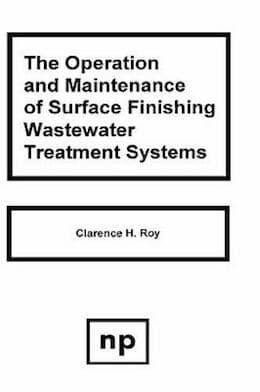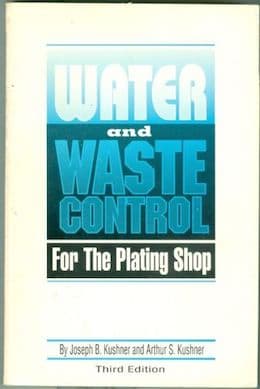
-----
Electroplating Wastewater Stats, Composition, Details
Q. Hi Friends,
I am a graduate student doing my thesis on electroplating industry. I am badly in need of some data. what I basically need is as follows: Concentrations of different metal ions in typical electroplating waste stream, say from tin plating line or from some plants itself. I would very much appreciate if anyone could send me the above information or at least pointers to where I will be able to find this information. Thank you, Srini.
Graduate Research Assistant, University of Houston, Houston, Texas
1995
A. Hello, Srini.
Do you mean before or after treatment? In the U.S., all plating shops must meet at least the effluent standards published in EPA 40CFR413 (Code of Federal Regulations). Most shops must meet the tougher standards of 40CFR433. You can find these on line. In general, we're looking at about 0.5 ppm to 4 ppm, depending on which standard applies and what metal you're looking at. Ironically, you mentioned tin which is, I believe, the only common unregulated metal.
It is more difficult, and an extrapolation, to give you typical effluent numbers before treatment, but 5 to 50 ppm is the best estimate I can give you for rinsewater from my experience. When a tank is dumped, which is rare, the numbers could easily be 50,000 ppm if it were not treated, .
Good luck.

Ted Mooney, P.E.
Striving to live Aloha
finishing.com - Pine Beach, New Jersey
Ted is available for instant help
or longer-term assistance.
Multiple threads merged: please forgive chronology errors and repetition 🙂
Q. Hi! My name is Andy Li. I am an Environmental Engineer in Taiwan. I read your discussion on WWW. May I have some questions?
1. Why most companies in the States send their concentrated to outside recycler and do not treat concentrated on site? Is that causing any problem in their treatment plant? And what is the problem? (for cyanide and Cr, Cu....)
2. What is the typical concentration of the rinse water and concentrates?
3. How is the sludge be treated by you and your recycler?
Very appreciate your help. Thanks!
Andy LiTaiwan
1996
by Clarence Roy

on eBay or Amazon
or AbeBooks
(affil link)
A. Hello Li. I do not agree that most shops send their concentrated waste off site, but when they do ...
1). In my opinion there are three main reasons concentrated wastes are shipped off-site:
a). because the particular waste is especially difficult to treat while remaining in compliance with permits--for example, nickel cyanide wastes;
b). because of questions about the legality of treating them--some misguided regulatory authorities weirdly believe that the purpose of wastewater treatment systems is to treat dilute rinse waters, and shop managers are afraid of running afoul of their interpretation.
c). because the particular waste has good economic value that shouldn't be wasted, like silver and gold, and electroless nickel.
2). Concentrated wastes are usually the same strength as the plating bath, acid tank, chromate, or cleaner. Dilute wastes from rinse water can vary tremendously but, in order of magnitude, are probably diluted between 100:1 to 1000:1 compared to the original plating bath.
3). Sludges are not treated by platers, except for removing some of the water. Most recycling companies probably kiln the waste and then use it as a raw material in traditional refining processes.

Ted Mooney, P.E.
Striving to live Aloha
finishing.com - Pine Beach, New Jersey
Ted is available for instant help
or longer-term assistance.
Q. Sir,
I would like to get information regarding characteristics and various processes in an Electroplating industries as well as wastewater treatment processes. Moreover please send me information regarding metal finishing journals. Which are the libraries in Chennai (India) is subscribing? Please inform me through mail.
Kindly do me this favour and I shall be highly obliged to you.
PRAMEENA SHEEJA- Chennai, India
2001
by Kushner & Kushner

on eBay (rarely)
or Amazon (rarely)
(affil link)
A. Hello, Prameena. Info on some of the metal finishing journals serving the industry can be found by following the link. We also list for you many of the classic electroplating books.
In the USA the EPA has countless case studies of the electroplating industry, which you can find by roaming around the site at www.epa.gov.
I don't know what libraries in Chennai subscribe to which periodicals, but the Metal Finishers Association of India, and the training institutes may have this info. For more on that, please see topics 97 and 1302.
(We'll advise you if your posting receives any followups, but this is a mutual help forum not a private consultancy, so we offer answers only in public postings, not private email).

Ted Mooney, P.E.
Striving to live Aloha
finishing.com - Pine Beach, New Jersey
Ted is available for instant help
or longer-term assistance.
The composition of Electroplating wastewater
Q. Hi,
I'm a researcher at the Cukurova University-Balcali/Adana/TURKEY. I'm trying to find general electroplating wastewater compositions. Especially Zn, Cu, and Pb concentrations. Thanks for your affinity.
Cukurova University - Adana, Turkey
2001
A. The concentration can vary tremendously depending on the processing method, the types of parts being plated, the metal which is being plated onto the parts, the flow rate used in the rinses, whether any recovery is done on the rinses, etc. The U.S. EPA has funded many studies on this which you should be able to start finding from www.epa.gov.
But if you just want a quick number to start from for order of magnitude, my experience is that the average jobshop generates wastewater that contains from the low to middle double digits of mg/l of the primary metals it plates. In other words, a zinc plating shop will often generate a waste of 15 to 70 mg/l of zinc; higher if they've been working at water conservation. The mg/l of secondary processes seems to run in the middle single digits, like 3-7 mg/l. Metals which are not used as platings, like lead in a shop that does no lead or solder plating seem to run in the low mg/l, like 1-3 mg/l. Again, the numbers could be higher if they are trying to reduce water usage, but probably aren't lower.
Again, this is not science, it's just typical of what I personally have seen, but should be helpful for a hypothetical plating plant for a school project. Good luck.

Ted Mooney, P.E.
Striving to live Aloha
finishing.com - Pine Beach, New Jersey
Ted is available for instant help
or longer-term assistance.
Need information about silver plating industry effluent
Q. I am doing ME project on recovery of silver from electroplating industry using polymer inclusion membrane. The concentration of silver may vary for different industries. I need information about effluent characteristics and discharge standards for silver plating industry. Could anyone send to me?
Regards,
b. saravanan BCentre for environmental science, Anna university. - Chennai, tamil nadu, India
2004
A. You know, I did a google search on the subject and got over 2000 hits. And you expect us to do your work for you?!

James Totter, CEF
- Tallahassee, Florida
A. Hi saravanan. A quick hint that might help you get started is that at least 95 percent of all silver plating is done from standard cyanide-based silver plating solution, and the same formula at the same concentration has been used for more than a century and a half. No one has invented a general purpose silver plating solution that is not cyanide-based and which is reliable and versatile enough for truly widespread application yet. Ion exchange and electrolytic recovery are the primary recovery technologies presently employed for silver plating installations.
Conditions vary too much in the plating industry for us to be able to summarize or generalize on silver plating effluent volume and concentration though. But there have been dozens of U.S. EPA studies on industrial wastewater. Although nobody in American industry ever utilizes this product of corporate welfare (beltway bandits make large political donations and are then rewarded with grants to "study" stuff that has already been studied to death) ... but it might be useful to Indian students for their school projects 🙂
Good luck.

Ted Mooney, P.E.
Striving to live Aloha
finishing.com - Pine Beach, New Jersey
Ted is available for instant help
or longer-term assistance.
Silver wastewater treatment
Q. Trying to find an efficient and effective means to treating silver in wastewater.
Synjon Smythplaters - Washington DC
2006
by Kushner & Kushner

on eBay (rarely)
or Amazon (rarely)
(affil link)
A. 1) Use a static rinse that you continually plate out of. This will minimize the loading on your flowing rinse waste treatment, as well as giving you a salable by product.
2) Plan on a bit more residence time in alkaline chlorination than you would for other cyanide rinses. I'd recommend 75 - 90 minutes. Silver cyanides are amenable to chlorination, but less so than zinc, cad, or copper cyanides.
3) Do polishing with a sulfur based treatment chemical, like sodium sulfide, DTC, or TMT. You will likely need to use a coagulant like alum or polyaluminum chloride with this. You will also need to do some bench testing to optimize the dosage of these, and to determine the optimum treatment pH.
Good luck!

Dave Wichern
Consultant - The Bronx, New York
A. Ion exchange can be used to recover the silver. For relatively small waste water streams, the typical approach would be: Rent two or three ion exchange columns, treat the rinsing water of the plating line until the exchange resin is exhausted and have the resin regenerated externally.
At a typical concentration of silver in the rinsing water (say 5 - 50 mg/l), the value of the silver should cover -/+ the expenses of renting the cartridges with ion exchange resin.
In some cases, the rinsing water can be reused after ion exchange treatment.
Best regards,
- Gent, BELGIUM
A. Ion exchange will work, certainly. You can capture the Ag(CN)2[-] on an anionic resin. But, now what?
People who regenerate IX bottles off-site will probably not accept them because of the cyanide. You could regenerate with a potassium hydroxide solution, a potassium cyanide solution, or a combination of the two. Then, you would have to concentrate the spent regenerant somehow and add it back to the bath. If you do this with heat at ambient pressure, you are liable to wind up with a lot of carbonates.

Dave Wichern
Consultant - The Bronx, New York
A. If you have a static tank and merely want to drop out the silver, you could let it plate out by adding some copper, plumbing pipe for example.
Regards
Ship Repair - Plymouth UK
Q. I need to know the average concentration of Cr+6 in electroplating wastewater according to your experiences, and also the pH of the very wastewater. Please send me a good e-resource.
Amir mousavi radstudent - tehran, Iran
January 18, 2009
A. Hi, Amir. I really don't think there are any meaningful "averages". Some shops do a little hexavalent chromating on zinc plating, using a small amount of quite dilute Cr+6 and have no other use for it. Other shops do chromating of aluminum as a mainstay and use a lot of this rather dilute solution. Still others do hard chromium plating exclusively, using a lot of much higher concentration chromic acid on all of the parts they process. In most countries, probably including yours, there are effluent standards that dictate that this waste must be treated before discharge.
Why are you asking? Are you looking for the numbers before waste treatment, or the concentrations in the effluent? If you want to do a project for a hypothetical plant, please tell us about that hypothetical plant and what they do. If you want average numbers, to decide for example whether a treatment technology would be economically viable, it's not going to work. Thanks.
Regards,

Ted Mooney, P.E.
Striving to live Aloha
finishing.com - Pine Beach, New Jersey
Ted is available for instant help
or longer-term assistance.
A. Electroplating industries discharge different heavy metals according to the type of metal solution used in the process. The concentration of hexavalent chromium can be found in the range of 700-1500 mg/l in wastewater. Nickel concentration can reach 150-400 mg/l in wastewater.
Mohammed Wateery- MYSORE, India
![]() Thanks Mohammed. Your numbers are before wastewater treatment of course, and could apply to a decorative nickel-chrome plating shop. I doubt that a shop whose mainstay is zinc plating or conversion coating of aluminum would reach numbers approaching that :-)
Thanks Mohammed. Your numbers are before wastewater treatment of course, and could apply to a decorative nickel-chrome plating shop. I doubt that a shop whose mainstay is zinc plating or conversion coating of aluminum would reach numbers approaching that :-)
Regards,

Ted Mooney, P.E.
Striving to live Aloha
finishing.com - Pine Beach, New Jersey
Ted is available for instant help
or longer-term assistance.
Q. Good day sir,
I am Jennlyn Jariol, a metallurgist and teaching in a university in the Philippines. I'm currently taking up my Masters on Environmental Engineering and recently doing my thesis proposal which is all about reclamation of heavy metals in the electroplating wastewater from a small scale electroplating shop. I hope you can help me on this sir.
This is my first time to write. I am confused about the difference on small scale electroplating and large scale electroplating and what is the basis to classify the electroplating industry/shop as small scale or large scale. I have been searching on the web about it. Thank you and God bless!
student - Villamonte, Bacolod City, Philippines
May 7, 2009
by Clarence Roy

on eBay or Amazon
or AbeBooks
(affil link)
A. There is not any global definition. To one person, 500 L tanks would be large and to another it might be 50,000 L.
A major difference is the type of plating that is done, IE: gold or platinum would use tiny tanks compared to a shop that plates bumpers.
- Navarre, Florida
A. You are the one who wants to do reclamation in a "small scale" shop, so you are the one who will decide what small scale means, Jennlyn.
James offered a good answer. Some plating shops have 5 or 6 waste-paper-basket-size plating tanks, and no employees except the owner. Others have 100 or more employees and a hundred or more tanks each capable of handling a truck bumper or larger. Everything in between exists.
At one point in the USA, the EPA offered more lenient effluent standards to shops which discharged less than 10,000 gallons of wastewater per day, so I suppose you could use that as the cut-off point between large-scale and small-scale if you wish to have something that you can at least make a reference to. (But some physically large shops with dozens of employees do manage to discharge less than 10,000 GPD). Good luck.

Ted Mooney, P.E.
Striving to live Aloha
finishing.com - Pine Beach, New Jersey
Ted is available for instant help
or longer-term assistance.
Q. I have a sample of a zinc plating wastewater which presents a high level of BOD (7.000 mg/L). What could be the origin of this organic matter? Detergents maybe? Does it make sense to you?
Thanks in advance.
- Santiago, Chile
March 29, 2012
A. Firstly, 7. mg/l O2 is a pretty low BOD. Did you mean 700, or 7,000?
Secondly, lots of brighteners used in Zn plating are organic acids, aldehydes, etc. that will be readily metabolized by bacteria. To lower your number, you might try preoxidation with H2O2. Or, you could chlorinate; that might give rise to other problems, though.

Dave Wichern
Consultant - The Bronx, New York
Ed. note: Some countries don't follow the same conventions as the USA when it comes to commas and dots in numerical data. Commas are sometimes used where we would use a decimal point, and dots where we would use a comma 🙂
Q. Hi sir,
I need to know how to find acid composition in electroplating wastewater.
- New Delhi, INDIA
July 14, 2016
![]() Hi Manish. We don't know whether you are an elementary school student, a post-doc, a regulator, author of a book on environmental engineering, chemist in a lab, wastewater treatment system operator, designer of lab instrumentation, etc. -- so there is no way to respond without numerous ifs-ands-&-buts.
Hi Manish. We don't know whether you are an elementary school student, a post-doc, a regulator, author of a book on environmental engineering, chemist in a lab, wastewater treatment system operator, designer of lab instrumentation, etc. -- so there is no way to respond without numerous ifs-ands-&-buts.
Please describe your situation and I'm confident that you will get good answers.
Thanks for your understanding.
Regards,

Ted Mooney, P.E. RET
Striving to live Aloha
finishing.com - Pine Beach, New Jersey
Ted is available for instant help
or longer-term assistance.
Q. You stated that dilute wastes (rinse water) can vary in order of magnitude between 100:1 to 1000:1 compared to the original plating bath.
Let's say a tank make up is 10 oz./gallon (chromic acid); using the 100:1 magnitude, then the concentration of hex-chrome in the rinse would be 0.1 oz/gallon, right?
What would be the concentration in ppm?
Thanks for your answer.
wastewater operator - Los Angeles
October 17, 2019
by Kushner & Kushner

on eBay (rarely)
or Amazon (rarely)
(affil link)
A. Hi Mike. A gallon of water weighs approximately 8.34 pounds, i.e., 133.44 oz. So 0.1 oz/gal would be 0.1/133.44 = 0.000749 or 749 ppm.
1000:1 dilution would be the better guess for chrome plating, so 1000:1 dilution would give you, say, 75 ppm. That sounds believable to me. Good luck.
Regards,

Ted Mooney, P.E. RET
Striving to live Aloha
finishing.com - Pine Beach, New Jersey
Ted is available for instant help
or longer-term assistance.
Q, A, or Comment on THIS thread -or- Start a NEW Thread